Ecommerce Warehousing: Definition, Benefits & Best Partner
By Macy -07/02/2025 UTC.
Managing an ecommerce business is a balancing act, and efficient warehousing is one of its most crucial components. From inventory management to order fulfillment, the logistics behind ecommerce warehousing can be complex.
That's where Ezbuy steps in, providing specialized warehousing services to ensure that businesses stay organized and operations run seamlessly. In this blog, we’ll define ecommerce warehousing, discuss its advantages, and explore how partnering with Ezbuy can help streamline your business operations and drive growth.
1. What is Ecommerce Warehousing?
Ecommerce warehousing is the management process for storing products sold online. It involves securing inventory, tracking product locations, keeping up-to-date records of stock quantities, and monitoring how long products have been stored. The process also covers the packing and shipping of products from the warehouse.
Technically, any designated area used for storing, organizing, tracking, packing, and shipping inventory for ecommerce can qualify as a warehouse. A traditional warehouse is not a requirement to apply this model. In fact, a lot of ecommerce startups begin with makeshift warehouses in spaces like garages or spare rooms before scaling to larger facilities to accommodate growing inventories.
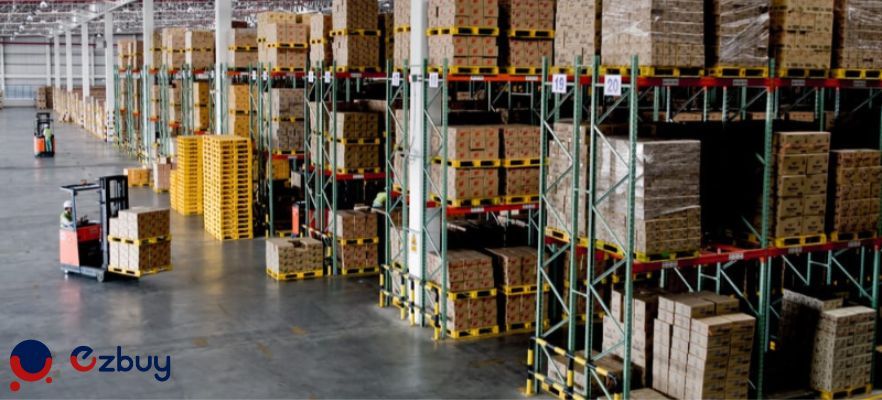
2. What is Ecommerce Warehouse Management?
Ecommerce warehouse management includes the daily functions and tasks of a warehouse, such as (though not restricted to):
- Providing training and overseeing the warehouse team
- Supervising the inventory, machinery, and safety procedures
- Establishing and nurturing partnerships with logistics partners
- Safeguarding products from damage or theft
- Calculating future shipping volume and workforce demand
- Receiving certifications and fulfilling licensing requirements
- Enhancing operational efficiency as the business scales up
- Maintaining compliance with safety guidelines
- Keeping a record of all shipments arriving and leaving each day
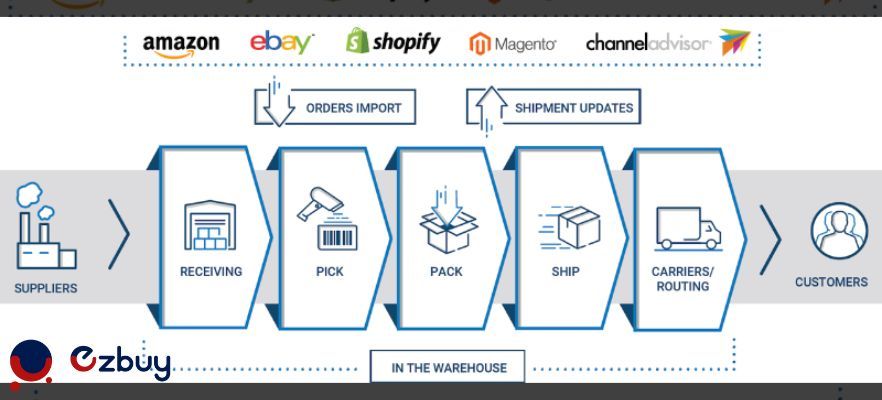
>>> Read more: The benefits of warehouse automation compared to manual warehouse operations
3. How Does Ecommerce Warehousing Work With Fulfillment?
Let’s explore the intricate relationship between ecommerce warehousing and fulfillment, exploring how these two processes work together to deliver a seamless customer experience.
3.1. Inventory Management
For precise SKU tracking at any time, it’s necessary to organize all items in the warehouse. Ensuring a seamless flow of products and parts from manufacturer to customer presents a tough operational challenge for any product-based business.
At its core, inventory management ensures that a distribution center holds the right number of SKUs to fulfill orders on time, without accumulating so much stock that it transforms into a warehouse for ecommerce business full of unsold products.
This process involves accurate forecasting of order volume, seamless communication with freight forwarders and manufacturers for regular product receipt, and utilizing a solid inventory management system to track stock in real time. These measures help prevent stockouts and avoid shipment delays due to backorders.
When implementing a strategy for distributed inventory across various warehouses, understanding the required resources, planning, and tools is essential. A top-tier warehouse will use systems to maintain real-time visibility of inventory counts. While manual inventory counting is still practiced in some places, technological advancements continue to reduce scanning and counting times year after year.
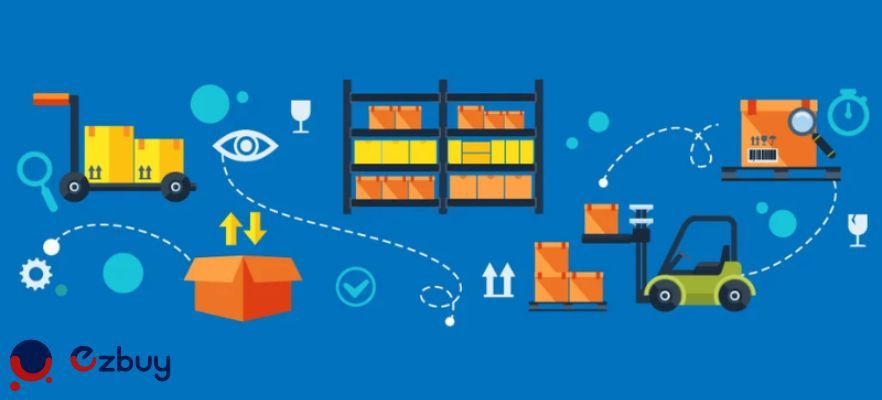
3.2. Order Picking
Upon receiving an online order, the distribution center is signaled to pick the item from the warehouse for e commerce companies. Picking items is a time-consuming, labor-intensive part of the supply chain. In a large warehouse filled with numerous SKUs from different companies, efficiently retrieving the correct item can be a complex challenge.
Advanced ecommerce fulfillment warehouse is designed with robust systems that help optimize both accuracy and efficiency in picking. A variety of picking techniques are applied, such as single order picking, zone picking, batch picking, and others.
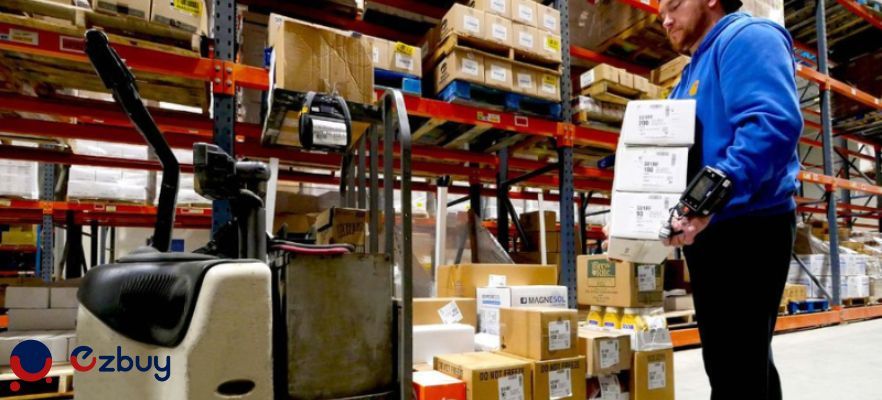
3.3. Assembly & Kitting
After being picked, the order is moved to a packing station in the distribution center, where it is placed into a shipping container. Any necessary additional materials are included before the package is labeled and shipped.
Some basic 3PLs limit their services to picking and packing, meaning items are picked, packed into parcels, labeled, and shipped directly. However, 3PLs offering value-added services and customizable fulfillment options take extra measures to enable clients to offer end-customers a more personalized and seamless experience, such as:
- Assembly: Assembly is the process of combining multiple parts to create a single product. In the case of consumer electronics, this can involve putting together several components before packaging or updating the device's software to its newest iteration.
- Kitting: Kitting refers to combining several items into one order. For CPG brands, this could mean ensuring that various flavors of a product, or items like a strap, camera lens, and tripod, are all part of the same order.
Accurate assembly and kitting require a distribution center warehouse to have robust IT infrastructure in place, ensuring that each package contains the correct components and items.

3.4. Shipping & Receiving
After an order is assembled with the correct parts, materials, and components, it is packaged and labeled for shipping. Carrier pickups at fulfillment center warehouses usually occur multiple times a day. The type of carrier service chosen depends on the number of products being picked up and where they are headed. The warehouse should be equipped with docks and stations to handle varying product volumes.
When sending multiple pallets to a retailer, the dock must be suitable for large freight trucks. For direct-to-consumer deliveries, smaller trucks and vans are used to pick up smaller quantities of product. Similarly, the distribution center requires sufficient space to unload pallets and stock them on the warehouse shelves.
The warehouse’s role in shipping and receiving is to ensure a smooth operation at each loading dock. To avoid delays and frustration, it’s crucial to have a modern scheduling system for dock appointments, as failing to do so will result in trucks and carriers waiting and causing disruptions.

3.5. Returns Management
Returns management (RMA) is a crucial part of ecommerce even though it is often given little attention by smaller companies. A warehouse should be prepared to manage a smooth process for receiving returned items, regardless of the return reason.
Certain warehouses and 3PLs offer additional services for their clients by offering services like refurbishing returned items, handling the disposal of unwanted returns, and giving end-customers real-time tracking to ensure their returns reach the warehouse.

3.6. Warehouse Operations & Management System
A great warehouse runs like a precision machine, where orders, systems, products, labor, and third-party partners collaborate effortlessly to achieve their objectives. Every warehouse function must integrate seamlessly, with the ultimate goal being the accurate and timely fulfillment of customer orders.
A Warehouse Management System (WMS) is an IT-driven software solution that automates warehouse operations. The main goal of a WMS is to increase the efficiency of order fulfillment while reducing errors from order receipt to shipping.
A WMS can contribute to various enhancements in the warehouse, including reduced fulfillment times, improved inventory accuracy, better picking precision, stronger customer support through traceability, optimized space usage, greater productivity, and a decrease in labor costs.

>>> Read more: Small Business Ecommerce Fulfillment: Boost Efficiency & Save Costs
4. Four Key Benefits of Warehousing Your Ecommerce Products
All ecommerce businesses, whether large or small, can see the benefits of warehousing. Here are 4 reasons why outsourcing ecommerce warehousing solutions for your products makes sense.
- Deliver your products to customers more quickly: As you determine where to store your inventory, consider spreading your stock across various warehouses around the country. This approach shortens the distance to your customers, helping you save on time and costs when shipping their online orders.
- Improve product organization: Warehouses are purpose-built for storing products, unlike spaces like your living room, guest room, or garage. Ecommerce warehousing enhances the precision of tracking inventory and helps avoid lost items. Using the right warehouse management system allows you to track turnover rates and reorder stock ahead of time.
- Decrease pressure: Ecommerce warehousing is much more than just organizing products on shelves. Offloading the extensive list of warehousing duties can be a great relief. With a well-organized process and the knowledge that your products are in safe hands, the difference can be remarkable.
- Save time: Time is a vital resource for ecommerce sellers. When you free up time previously spent on searching through product piles or managing cluttered storage, you can shift your focus to growing your business. The time saved by outsourcing warehousing can outweigh the costs, since time is closely tied to profitability.
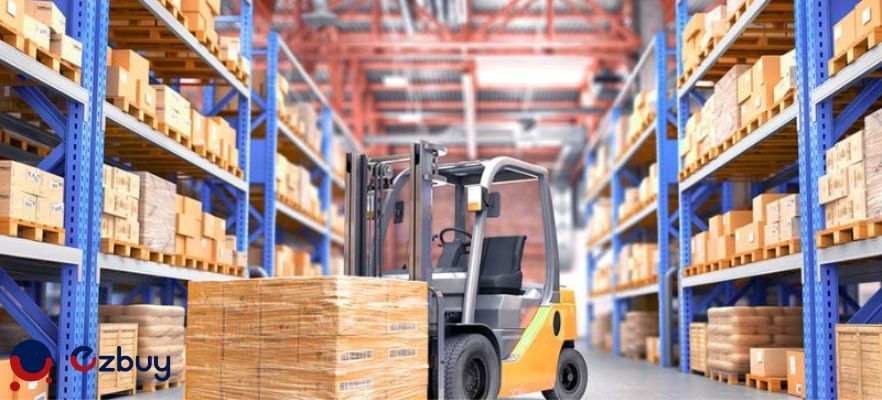
5. What Happens Without Ecommerce Warehouse Management?
From home storage to leased warehouse space, the absence of ecommerce warehouse management can cause complications. Here’s what might happen if this system is missing:
- Inventory can become misplaced: An ecommerce warehouse management system ensures that each product variation on your site has a designated storage location. Without this, inventory can easily get lost, particularly as your business and range of products expand.
- Wrong shipment: If inventory isn’t carefully monitored, there’s a risk of sending the wrong products to customers, which could turn off first-time customers and push away regular ones. A good warehouse management system can enhance customer experience and positively influence your overall revenue.
- Warehouse capacity runs out of space: Many small businesses run into storage problems at home as inventory grows. Once storage capacity is reached and there’s no room for new stock, it can cause stockouts of in-demand products. If you can’t restock due to limited space, you could miss important sales opportunities, especially during high-demand times like peak seasons or sales events.
- Inventory shortages or overstocking: With strategic ecommerce warehouse management, you can determine the optimal amount of inventory to hold. Too few items can lead to stock-outs and lost sales, while too many can leave you with obsolete stock and higher storage costs. By controlling inventory levels effectively, you can redirect those savings to other areas.
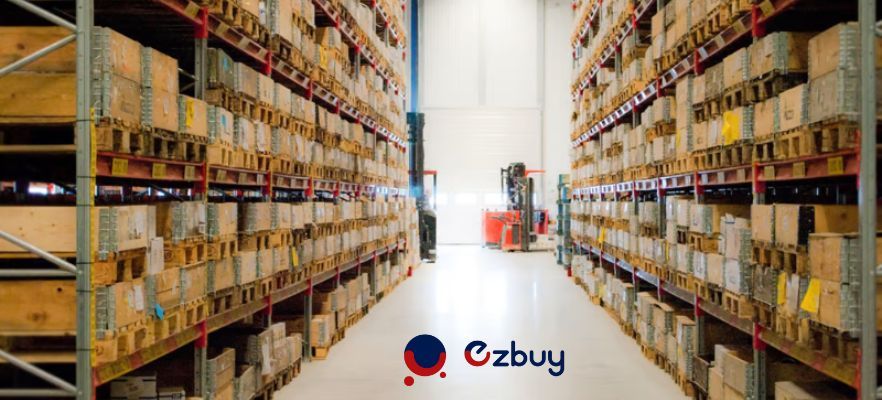
6. Ecommerce Warehousing With Ezbuy Japan
To scale successfully in ecommerce, a reliable and efficient warehousing solution is crucial. Ezbuy Japan offers a comprehensive warehousing service, designed to help businesses manage inventory, store products, and handle shipping with efficiency and ease.
Our advanced warehouse management system and experienced team work together to provide smooth order processing, packing, and shipping, letting you focus on what matters most - business growth. Let’s explore why Ezbuy Japan stands out as your best ecommerce warehouse partner.
- Effective and timely order fulfillment: With high-tech equipment and efficient systems in place, Ezbuy Japan’s warehouse ecommerce fulfillment centers enable rapid and precise order processing. As a result, customer orders are efficiently picked, packed, and dispatched on time.
- Budget-friendly fulfillment services: The expansive network and strong ties with multiple shipping partners allow us to negotiate excellent shipping rates,resulting in cost savings for businesses on their delivery costs.
- Premium packaging solutions: Ezbuy Japan’s fulfillment centers use professional packing techniques to protect products in transit, minimizing potential damage and ensuring a more positive experience for the customer.
- Seamless eCommerce integrations: Ezbuy Japan integrates with different eCommerce platforms such as Amazon Japan, Y! Auctions, etc, allowing businesses to easily connect their online stores to our fulfillment system. This connection simplifies the processes of managing inventory and tracking orders.
- Broad network of order fulfillment locations: Ezbuy Japan’s strategically located fulfillment centers enable businesses to distribute products efficiently across multiple regions, resulting in faster deliveries and lower shipping costs.
- Well-organized returns handling: Ezbuy Japan simplifies the returns and refund process in our warehouse, allowing businesses to handle these tasks with ease. This is crucial for keeping customers satisfied and ensuring their trust in the brand.

>>> Read more: Comprehensive Guide to Japan Warehouse Service
7. Conclusion
In conclusion, ecommerce warehousing offers a range of advantages, from improved inventory management to faster shipping and reduced overheads. By selecting a reliable and experienced warehousing partner, your business can benefit from greater efficiency and scalability.
By entrusting Ezbuy with your warehousing, you're ensuring that your products are managed and shipped efficiently, giving you more time to focus on what really matters - growing your brand.
Website: https://ezbuy.jp